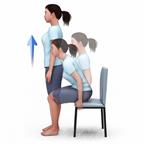EsteéoconteúdodoPacientEngagement
O que acontece quando o paciente vai para casa?
Saiba mais sobre nossos produtos de Patient Engagement agora! Transforme seus pacientes em participantes ativos em seus cuidados de saúde, dando a eles acesso fácil às mesmas informações baseadas em evidências em que você confia - mas fornecidas em um formato fácil de entender.

Sit-to-stand exercises can help you get stronger after an injury or health problem. This exercise is also called the chair stand or chair rise exercise. The goal is to stand up from a chair without using your hands.
Make sure you know how to do the exercise safely. Follow the steps below. It's normal to feel mild discomfort. Stop if you feel pain or your pain gets worse.
Do not start this exercise until told by your health care provider.
The sit-to-stand exercise makes the muscles in your lower body stronger. It also helps with balance and control of your body.
This exercise is helpful if:Do this 10–15 times. If that's too hard, start with fewer times to build up strength.
Rest for 1 minute, then do another set.
To make the exercise easier or harder
If it's too hard:This information is not intended to replace advice given to you by your health care provider. Make sure you discuss any questions you have with your health care provider.
Cookies são usados neste site. Para recusar ou saber mais, visite nosso conheça nosso aviso de cookies.
Copyright © 2025 Elsevier, its licensors, and contributors. All rights are reserved, including those for text and data mining, AI training, and similar technologies.